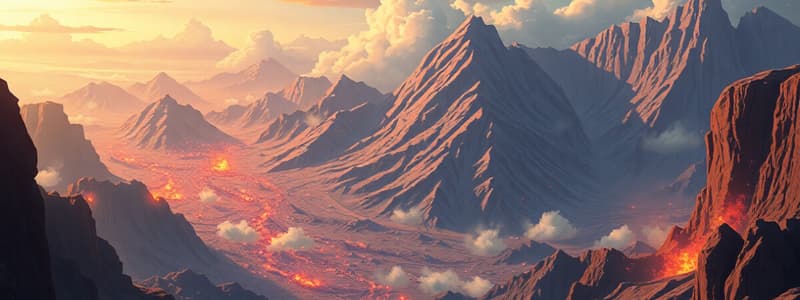Podcast
Questions and Answers
What is the primary effect of stress on rock?
What is the primary effect of stress on rock?
- To create seismic waves
- To melt it into magma
- To change its shape or volume (correct)
- To change its temperature
Which type of stress involves pulling the Earth's crust, causing it to thin?
Which type of stress involves pulling the Earth's crust, causing it to thin?
- Compression
- Contraction
- Shearing
- Tension (correct)
What is a characteristic of Aa lava?
What is a characteristic of Aa lava?
- Fast-moving and hot
- Slow-moving and cooler (correct)
- Produces explosive eruptions
- Always flows smoothly
Where do volcanoes most commonly form?
Where do volcanoes most commonly form?
Which term describes the point in the crust where an earthquake begins?
Which term describes the point in the crust where an earthquake begins?
What type of volcanic eruption is associated with a Composite Volcano?
What type of volcanic eruption is associated with a Composite Volcano?
What is the definition of viscosity in relation to lava?
What is the definition of viscosity in relation to lava?
What occurs during a tsunami?
What occurs during a tsunami?
Flashcards
What is stress?
What is stress?
The force that acts on a rock to change its shape or volume.
What is Divergent stress?
What is Divergent stress?
A type of stress where the force pulls a rock in opposite directions, making it thinner in the middle.
What is Convergent stress?
What is Convergent stress?
A type of stress where the force pushes a rock in opposite directions, causing it to fold or break.
What are seismic waves?
What are seismic waves?
Signup and view all the flashcards
What is magnitude?
What is magnitude?
Signup and view all the flashcards
What is a Tsunami?
What is a Tsunami?
Signup and view all the flashcards
What is viscosity?
What is viscosity?
Signup and view all the flashcards
What is a pyroclastic flow?
What is a pyroclastic flow?
Signup and view all the flashcards
Study Notes
Earthquakes & Volcanoes Study Guide
- Stress: The force that acts on a rock to change its shape or volume.
- Tension: Pulling the Earth's crust, getting thinner in the middle.
- Compression: Squeezing rock until it folds or breaks.
- Shearing: Force pushes a mass of rock in two opposite directions.
- Fault: A fracture in Earth's crust.
- Earthquake: Shaking and trembling from the movement of Earth's crust plate boundaries.
- Seismic Waves: Energy carried from an earthquake's focus.
- Magnitude: Measurement of an earthquake's strength (a single number based on size).
- Tsunami: A giant wave caused by an underwater earthquake.
- Viscosity: How thick a liquid is and how easily it pours.
- Aa Lava: Slow-moving, cooler lava that dries rough.
- Pahoehoe Lava: Fast-moving, hotter lava that dries smooth or ropey.
- Pyroclastic Flow: Hot, dense mixture of ash, gas, and rock fragments from a volcano.
- Magma: Molten material in the Earth.
- Lava: Molten material on the Earth's surface.
- Volcano: A weak spot in the crust where magma comes to the surface.
- Hot Spot: An area where lava frequently erupts at the surface, independent of plate boundaries.
- Focus (Earthquake): Point in the crust where an earthquake begins.
- Epicenter (Earthquake): Point on the Earth's surface directly above the focus.
- Seismograph: Instrument used to record ground movements caused by seismic waves.
Volcano Types
- Shield Volcano: Quiet eruptions, AA and Pahoehoe lava.
- Cinder Cone Volcano: Quiet eruptions, AA lava.
- Composite Volcano: Explosive eruptions, AA lava.
Seismic Waves
- Primary (P-waves): Compress and expand, travel through solids and liquids.
- Secondary (S-waves): Vibrate side-to-side and up-and-down, travel only through solids.
- Surface Waves: Travel along the surface, cause the most damage.
Studying That Suits You
Use AI to generate personalized quizzes and flashcards to suit your learning preferences.
Related Documents
Description
This study guide covers essential concepts related to earthquakes and volcanoes. It includes definitions and explanations of key terms such as stress, tension, seismic waves, and types of lava. Ideal for students preparing for exams in Earth Science.



